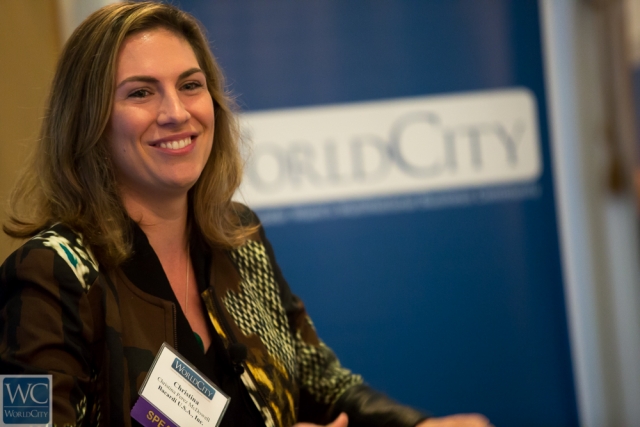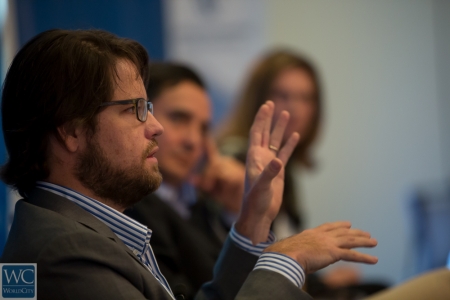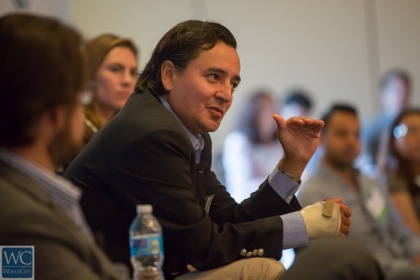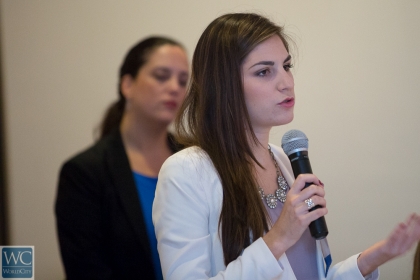Social media: What’s Changed SInce Yesterday?

Forget about hiring a Millennial intern and spending $10,000 for them to post on Facebook and Twitter.
As digital marketing becomes more sophisticated, companies need to integrate social media into their broader business goals and approach it more strategically. That means figuring out who to target as customers, which social-media best reaches them and effectively measuring results.
“The first layer of any social-media strategy is a clear understanding of your business objectives,” said panelist Gustavo Garcia, vice president of digital for Miami and Latin America at Edelman, the global public relations and communications firm.

Gustavo Garcia, vice president of digital for Miami and Latin America at Edelman, the global public relations and communications firm. Photos by Carlos Miller
Those were among the insights shared at WorldCity’s Global Connections held Sept. 26 on the topic, “Social Media Marvels: What’s Changed since Yesterday?”
User numbers show social media’s growing importance. Twitter now handles about 500 million tweets per day. And Instagram now boasts more than 200 million users, up about 50 million in the last six months, said WorldCity President Ken Roberts.
Crafting a social media campaign for a new brand
Bacardi USA opted for a digital and social media approach to launch its new flavored whiskey in the U.S. market called William Lawson’s, said panelist Christina Perez McDowell, a senior brand manager for whiskies at the US unit, who is pictured above.
The new brand is positioned as “a bit irreverent. It doesn’t play by the rules. It’s cheeky,” she said. It’s targeted at Caucasian males in their college years, generally 21 to 24 years old.
Bacardi’s initial approach: A partnership with the website CollegeHumor.com, which offers “a lot of content on the playful side,” she said.
The campaign will start in six states that each have big colleges known for football. Bacardi will show two videos, one about tail-gaiting during football season. The company will monitor how much each video is shared among ways to decide which to show when and to gauge their effectiveness, she said.

Leonel Azuela, managing director of Quaxar, which provides e-loyalty and community marketing solutions.
Making the two videos was much different and cheaper than producing ads for national TV. The crew was essentially one person, not a big team, and the quality of production “grittier,” said McDowell.
Do’s and don’ts for video on social media
Social-media marketing has been moving from text to images and into video, said Leonel Azuela, managing director of Quaxar, which provides e-loyalty and community marketing solutions.
Yet even Spanish-language TV network Telemundo has learned that video marketing online is not as simple as placing a segment of a TV soap opera on Facebook or YouTube. Viewers don’t want 40-minute TV shows on social media on traditional soap-opera topics like rich man meets poor girl, said Azuela.
Instead, social-media viewers prefer shorter videos on topics more relevant to their lives. So, Telemundo now is developing segments for online, each roughly 7-8 minutes and exploring themes like immigration. The idea is to spark social-media conversation that will prompt viewers to increasingly watch and share those online segments, Azuela told the group.
The BBC has found that social-media talk also helps build viewership for TV. Online discussion about BBC’s recent “Doctor Who tour” prompted folks to watch repeats of the TV show or record the show to watch later, sending ratings up, said audience member Roberto Mercado, director of ad sales and programming research for BBC Worldwide Channels for Latin America and US Hispanic.
“There has to be a synergy between TV and social media, not to outdo each other but to complement each other,” Mercado said.

Roberto Mercado, director of ad sales and programming research for BBC Worldwide Channels for Latin America and US Hispanic.
Crisis management on social media
Social media can be so powerful it can overwhelm a company, said audience member Eduardo Diquez, senior consultant with Auxis management consulting firm.
That’s what happened to a young business whose online marketing drew so many customers that it could not meet demand. Some disappointed customers complained on social media, and sales slipped. The company closed down its website, said Diquez. How should it have reacted to that crisis?
“Come clean, be transparent as to what has happened, try to solve things as quickly as possible, and offer some kind of compensation,” suggested Garcia of public relations firm Edelman.

Eduardo Diquez, senior consultant with Auxis management consulting firm.
That’s what Home Depot did successfully after its recent data breach, even offering customers one year of data monitoring free, said Garcia.
“In the end, people will appreciate it if you deal with it, not close down,” added Azuela of Quaxar. “Acknowledge the problem. We’re human. It’s okay to fail.”
What’s more, do it quickly, if only to say that you’re seeking a solution, said Bacardi’s McDowell.
“Rough and soon is better than perfect and late” in response to a crisis, said McDowell.
Social media for business-to-business marketing or surgeons?
Social media seems to work better for marketing business-to-consumer relations than business-to-business, said Tak Takasu, managing consultant with Competitive Intelligence and Strategy Analysis.
How can you maximize social-media conversation between businesses?, Takasu asked.
“Be patient,” said Azuela. “Analyze everything and build on those threads of conversation with people who do engage.”
Does it make sense for all businesses to use social media for marketing, even a surgeon?, asked Vanessa Paredes, communications manager at the Greater Miami Chamber of Commerce.
“It depends who you go after,” said McDowell. A surgeon might not target individual customers on social media but seek out an “influencer,” who could recommend him as a specialist, she said.
A specialty business also might buy very targeted ads on social media and websites, added Garcia.

Vanessa Paredes, communications manager at the Greater Miami Chamber of Commerce.
Social media changing business itself?
What impact is social media having on business itself?, asked Mel Maguire, senior executive director of management development at Florida International University’s College of Business.
“Social media has transformed the whole [communications] industry,” said Garcia. Earned media, not purchased or owned media, “has become the holy grail that everyone is after.”
Still, within major corporations, social media still needs to find a seat at the executive table.
Getting there entails building bridges with top executives by focusing on broad corporate goals that social media can help them achieve. To move beyond being that “website guy” or “social media guy,” suggests Azuela: “Get buy-in from the CEO and decision-makers.”
Global Connections is one of six event series organized by media company WorldCity to bring together executives on international business topics in greater Miami. The Global series is sponsored by Edelman, FIU Business, real estate company Waterford and air-conditioner maker Daikin.
The next Global Connections is set for Oct. 31 on the topic, “China: Latin America’s other superpower partner.”